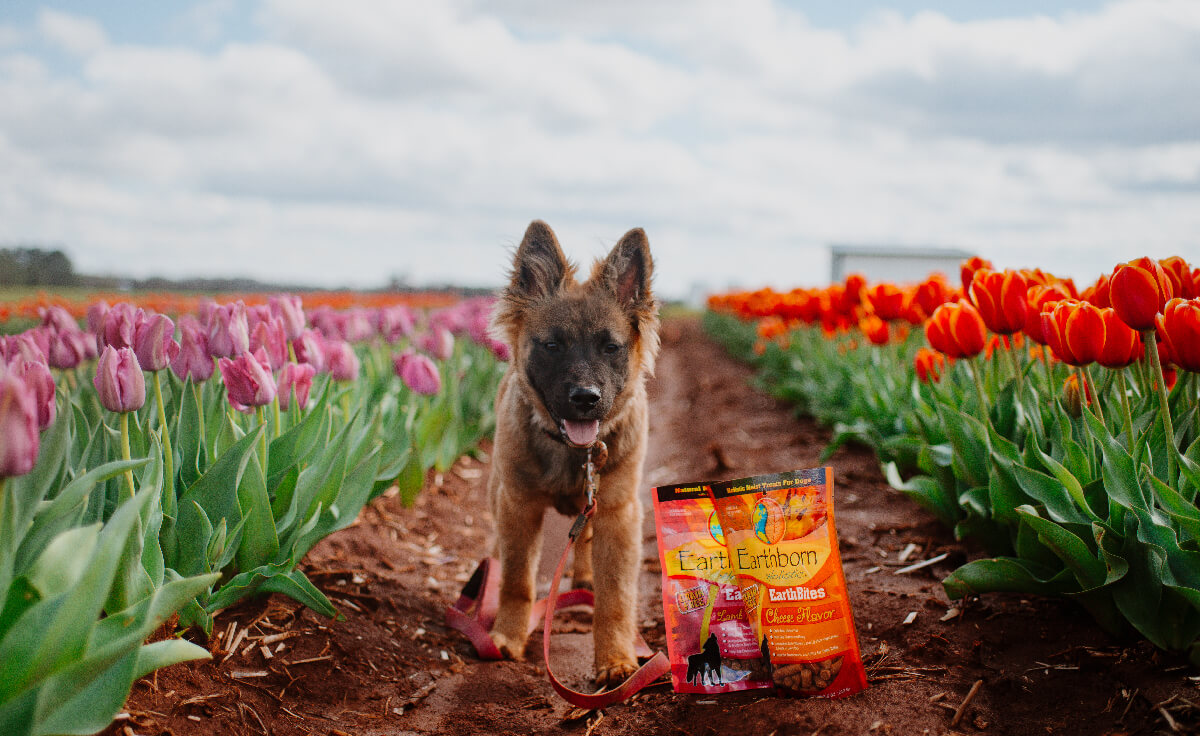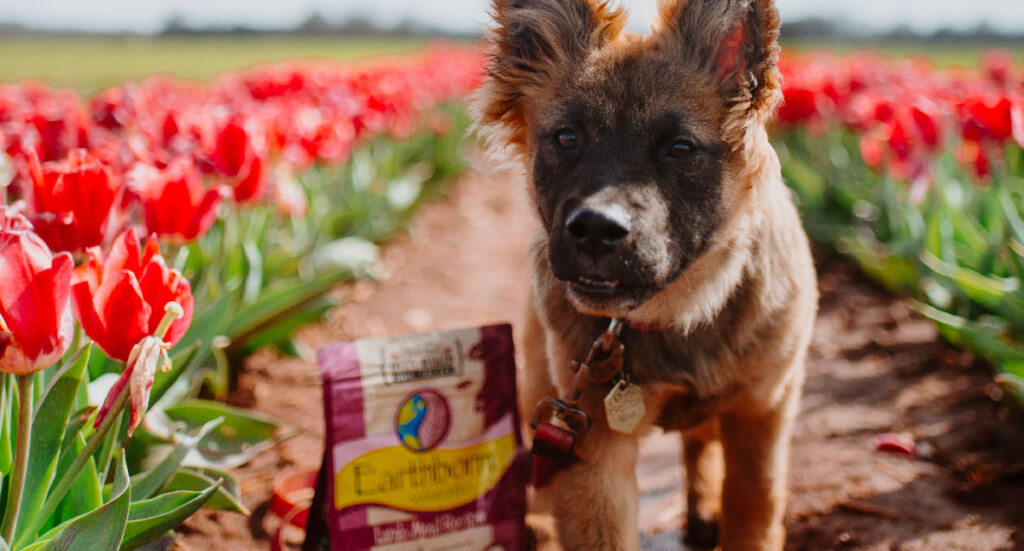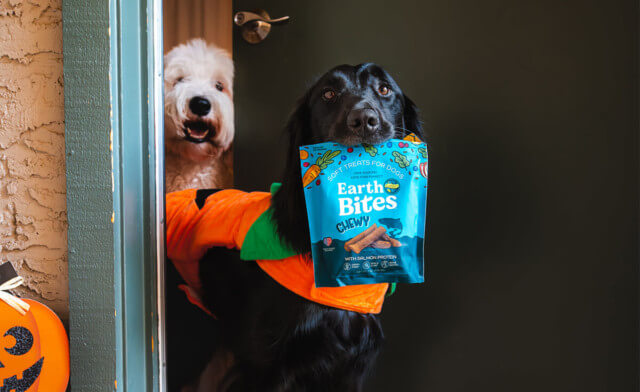Springtime Seasonal Allergies in Dogs
Spring is here, the sun is shining, the birds are chirping, and your dog is… itching? If you’ve experienced seasonal allergies yourself you know how much of an annoyance it can be, but did you know your dog can also have seasonal allergies? If you notice your dog seeming to have a rough time when the weather starts to turn, allergies may be the culprit. Learn what allergy symptoms in dogs to watch out for and learn what to do if you find out your dog does have seasonal allergies.

Do Dogs Get Seasonal Allergies?
With springtime and an occasional stuffy nose right around the corner, you may be wondering, “Do dogs get seasonal allergies?” While dog seasonal allergies are different from human seasonal allergies, they do still exist. In fact, a dog pollen allergy or other environmental allergies is fairly common, but are harder to test for. You’ll need to visit your vet and ask them to do an allergy test to determine what exactly your dog is allergic to, but if you catch yourself wondering, “why is my dog itching so much,” it may be a sign that an allergy test is in order.
Depending on what symptoms your dog is showing and how often, your vet may order a series of skin tests or blood tests to pinpoint the allergy.
Symptoms of Seasonal Allergies
“Why is my dog itching so much?” “Why are my dogs eyes red?” “My dog has dry, flaky skin and scabs!” If you’ve said any of these things and you find your dog itching (no fleas in sight) when the springtime season rolls around, it could be one of the many dog seasonal allergy symptoms. According to the Animal Humane Society, here are some pet seasonal allergy symptoms to look out for:
- Scratching and biting their coat or skin
- Red, inflamed, or infected skin
- Excessive shedding
- Compulsive paw licking in dogs
- Boot scoots or licking their anal glands
- Chronic ear infections or red, waxy ears (common for dogs who are prone to ear problems in the first place)
- Respiratory issues, such as difficulty breathing, coughing, or wheezing (more common in cats)
If you notice your dog showing any of these symptoms, schedule a vet visit so you can figure out exactly what’s going on.
Grasses, Trees, and Weeds
While it might sound silly, your dog actually can be allergic to grass and the great outdoors. According to North Hill Vet, “Dogs can be allergic to grass, and it’s more common than you might think. In a study completed at the University of Veterinary Medicine Vienna, more than 80 percent of 262 trialed dogs tested positive for grass, weed, and tree pollen allergies.”
For a dog allergic to grass, symptoms are very similar to many other environmental allergies. For this reason, if your dog is showing what you think may be grass pollen allergy symptoms or tree pollen allergy symptoms you’ll need to check with your vet. They’ll need to perform an allergy test to find the culprit. That being said, the odds of you thinking your dog is allergic to grass over other things is probably pretty slim since the symptoms are similar to a variety of other things. If you notice anything is off with your dog, be sure to schedule a vet visit to get to the bottom of it.
If it’s discovered that your dog does have a grass or tree allergy, North Hill Vet gives some great tips on things you can do at home to help limit symptoms as much as possible:
“Firstly, it might be a good idea to keep the area in which your dog plays free of tall grasses and mowed on a regular basis. Any grass that features heads may irritate their skin.
“It may also be helpful to keep your eye on mobile weather apps. These apps can offer helpful, up-to-the-minute pollen level indicators to give you a good idea of when to limit outdoor play time. If your dog does play outside in grass a lot, wiping down their legs and feet with warm water after playtime might also help to remove any pollen that has come into contact with your dog’s skin or fur.
“If symptoms and irritation still occur, and your dog is uncomfortable, be sure to call upon your local veterinary professional for help. They might be able to recommend anti-itch shampoos and sprays to relieve discomfort, and may even prescribe allergy shots in severe cases.”

Mold Spores
If your dog has an itchy stomach or skin, a mold allergy rash, or dog hair loss patches, all of these could be a sign of a mold spore allergy according to Whole Dog Journal:
“Mold allergies tend to manifest as a skin condition. Symptoms may include scratching (often persistent), inflamed and irritated skin; dry scaly skin, localized or generalized hair loss in dogs, chewing/licking (especially the paws); chronic ear infections. It is also possible, but uncommon, for molds to cause respiratory symptoms such as coughing, sneezing, wheezing, labored breathing, discharge from nose and/or eyes, and even loss of appetite and lethargy in more severe cases. Dogs with mold allergies are also frequently affected by other inhalant allergens, such as mites.”
Mold allergies are a type of allergy that can only be determined by allergy testing. If you think your dog has any kind of allergy or is showing mold allergy symptoms, it’s important to visit your vet to determine what your dog is allergic to so you can set a treatment plan to find your dog some relief.
House Dust Mites
Another common thing that your dog could develop an allergy to is house dust mites. If you find yourself thinking, “why is my dog scratching so much while we’re inside?” and you notice that while your dog is scratching a lot indoors but not as much outdoors, dust mites might be the culprit. Compared to seasonal allergies, allergies to dust mites last year-round which make them a little harder to diagnose.
According to Wag Walking, the best way to help allergies to mites in dogs is by getting rid of as many dust mites in your home as you can:
“It is virtually impossible to get rid of them all, but you can make a significant difference by getting rid of carpeting and replacing upholstered furniture with vinyl, leather, plastic, or wood. Use pillow and mattress covers on your dog’s bed as well as your own. You will need to wash all bedding in hot water weekly, or get them professionally cleaned if possible. Studies have shown that professional cleaning gets rid of up to 60% more dust mite allergens than home laundering. Another thing you can do is to use blinds or shades instead of curtains or drapes. Anything that can collect dust (stuffed animals, knickknacks, books) should be removed if you are not prepared to clean them thoroughly every day The carpet is the main culprit of dust mite allergens, but if you cannot get rid of the carpeting, you should steam clean weekly and thoroughly vacuum daily. Be sure to use a HEPA filter on your vacuum cleaner.”
Other Allergies
While seasonal and food allergies tend to be the most common allergies that dogs can have, that doesn’t mean you should discount other allergies that can be determined by allergy testing at your vet. Here are some other allergies that are less common, but still prevalent, that you should know about:
- Wool allergy: An allergy that shows itself as a contact allergy, a wool allergy can be a problem if you have wool blankets in your house that your dog likes to lay on.
- Laundry detergent: Similar to the material of blankets, your dog may not be allergic to the actual blanket but instead the laundry detergent you’re using on the blankets. If this is the case, you might look into a dog-safe laundry detergent.
- Tobacco allergy: Believe it or not, the effects smoking can have on the humans around you is similar to the second hand smoke effects on pets. Tobacco and smoke is bad for dogs and can cause lung issues just as it can for humans. If you smoke around your dog and notice them potentially developing issues, definitely see your vet.
- Medicines: Just like humans, dogs can also be allergic to certain medicines. Common medicine allergies in dogs are actually allergic reactions to flea medicine, especially if it’s a topical medication. In these cases, you might need to try a pill version of the flea medication. If you think your dog or yourself are allergic to your dog’s medicine, definitely check with your vet to explore other options.
Is It Seasonal Allergies or Food Allergies?
If you’re trying to determine if your dog has seasonal allergies or dog food allergies, this is a conversation to have with your vet. Seasonal allergies and food allergies are treated very differently, so making sure that you know which one your dog has is important.
When it comes to food allergies, dogs’ skin is usually the first sign pet parents notice. If your dog has food allergies, you’ll probably start to notice them itching a lot more than usual or they’ll have red or inflamed skin, among other allergy symptoms in dogs like licking their paws.
If your dog does have food allergies, your vet will likely recommend a change in diet and removing the ingredient that’s causing the reaction. Depending on what the ingredient is (and if there’s more than one) changing to a different recipe similar to the one you currently feed could do the trick. If there’s multiple ingredients causing a reaction or if it’s a more common ingredient, your vet may recommend switching to a limited ingredient dog food.
Limited ingredient diets are made with dogs who have allergies or sensitivities in mind. With fewer common allergens and fewer ingredients in general, limited ingredient recipes are a great option to provide your dog with allergies some relief.
If you notice that your dog’s allergy symptoms are seasonal, odds are they aren’t food related and you should look into whether or not your dog is affected by environmental allergens. Seasonal allergies can usually be noticed by things like your dog sneezing and runny nose, along with itching or flaky skin. A dog runny nose is usually the most telling sign of environmental allergies instead of food allergies, especially if it only happens during certain times of the year.

How to Help Your Pup With Seasonal Allergies
When it comes to seasonal allergies in dogs, there are a few ways you can help provide your pet some relief. Just like humans have allergy medicine, dog allergy medicine is something you can look into by visiting your vet. If your dog’s allergies are bad enough, your vet may be able to prescribe and antihistamine for your dog to help with some symptoms.
If you don’t think your dog’s allergies are quite bad enough to warrant a prescription antihistamine, there are some other things you can do around your house worth trying that could also make a difference. For example, wiping off your dog’s paws often with dog paw cleaner wipes is a great way to keep them from tracking a bunch of allergens inside. These pet wipes from Earth Rated are great for this and can be used to wipe your dog off after coming in from outside.
Cleaning your house a little more than usual can also help with seasonal allergies. We’ll touch on this more later, but how to get rid of mites in your house and how to get rid of mold spores in the air in your home is really just to clean the best you can and, if necessary, get help from professional cleaners or mold removing specialists. Keeping your house as clean as you can and vacuuming often can help keep dust mites and mold at bay.
If your dog has dog food allergies, on the other hand, these will only be cleared up by figuring out what ingredient (or ingredients) your dog is actually allergic to and then removing them from their food.
Spring Cleaning Tips to Relieve Allergies
If your dog seems to have seasonal allergies, it might (unfortunately) be time to step up your spring cleaning game. Adding a few things to your spring cleaning checklist may provide your dog more allergy relief than you might think, so if your dog seems to be struggling then it’s definitely worth a try.
Floors & Carpets
Keeping your floors and carpets as clean as possible is one way to potentially decrease the amount of allergens in your home that are affecting your dog. By investing in a good vacuum and dog carpet cleaner, you can keep the allergens to a minimum. One of the best vacuum cleaners for dog hair that we love is from the Bissell brand. Their CleanView Swivel Rewind Pet Upright Vacuum has raving reviews and even HGTV named it the best overall vacuum for pet hair. It has a HEPA filter for allergies and a rotating brush to get pet hair off your upholstery. When it comes to how to get dog hair out of carpet or other pesky allergens, this vacuum is a great start.
Other Household Surfaces
Keeping a clean house in general can help, especially if your dog has allergies to dust mites or other things that can be tracked indoors. For this, you’ll want to make sure you have dog-safe, non-toxic cleaning products to help you keep your house nice and tidy. If you’re not new here, you probably know where this is going. If you are new, we’d love to introduce you to Cedarcide All-Purpose Cleaner. This cleaner is safe for kitchens, bathrooms, and pet spaces and is made with worry-free ingredients you can feel good about using around your pets.
Cleaning Your Dog
You’ve got your whole house cleaned to contain your dog’s allergies, but what about your actual dog? Cleaning your dog often (and especially after they come in from outside if you’re dealing with pollen allergies) is another important step you can take to help your dog’s allergy symptoms. More frequent baths with a dog shampoo for allergies or using dog-friendly wipes to wipe your dog down before they come in from outside can make a big difference, too.
Tips for Bathing Your Dog
Speaking of dog shampoo, you might be wondering how often you should bathe your dog with skin allergies. Or how often you should bathe a dog in general.
In general, how often you should bathe your dog depends on a variety of factors. Typically if your dog has a more high-maintenance coat they’ll require baths more frequently, sometimes once a week. If your dog tends to have a low-maintenance coat, bathing can be spread out to every 45 weeks. You don’t want to bathe your dog too often, as this should throw off their skin’s natural oil production and lead to dry skin.
That being said, if you have a dog with skin allergies they could benefit from being bathed up to twice a week with a dog shampoo formulated to help with skin allergies. In these cases, the shampoo acts almost like a “medicine” and can help soothe your dog’s skin and allergies significantly.

How to Bathe a Dog
Before you give your dog a bath, it’s always a good idea to groom them first. If you don’t groom your dog and get all of the loose hair out before getting it wet, especially if you have a long-haired dog, it could cause matting. So give your dog a good brush before getting them in the tub. If you’re wondering what tools you should have in your dog grooming kit, here’s what we recommend:
- Nail clippers
- FURminator DeShedder Brush (for short hair dogs)
- FURminator DeShedder Brush (for long hair dogs)
When the time comes to actually give your dog a bath, the best way to do it really depends on how tolerant your dog is. Some dogs love bath time while others hate it, so start slowly to figure out which side of the spectrum your dog lands on. Depending on that, you might find that an outdoor dog bath may be the best option, especially if you have a large breed. Have a dog that doesn’t love bath time and looking for a dog bath helper? Peanut butter is a great option. Spread some on the wall of your shower and let your pup lick it away as you bathe them for a great distraction!
Springtime Insect Safety
With springtime often comes dreaded insects and while no human wants to be bit, insect bites on dogs are just as annoying. If you’re getting outside and are wanting to protect against fleas and ticks, we love the Cedarcide Flea & Tick Pet Brush for an easy way to give your pet another layer of protection.
If your dog unfortunately has fleas, you might be wondering how to get rid of fleas on dogs. If your dog does okay in the bath, giving them a good scrub is a good way to get rid of the fleas. If your dog is allergic to fleas, their skin might be more sensitive so check with your vet before giving your dog a bath to get rid of them.
Second, you’ll need a flea comb, as getting all of them off of your dog is the best dog flea treatment. According to PetMD, “Fleas are tiny, fast, and difficult to grab. One way to remove them from your pet’s fur is to use a flea comb. Dipping the comb in a mixture of water and dish soap will help to catch the insects, keeping them from jumping away. The teeth on a flea comb are spaced to trap fleas while they allow your pet’s fur to pass through. Flea combs also help remove flea poop, sometimes called “flea dirt” — dark brown or black specks that look like pepper flakes. The comb can also help to remove eggs from your pet’s fur. Be sure to take special care while you comb around your pet’s neck and tail areas. That’s where fleas tend to feed.” After this, you’ll want to make sure you use a product like the Cedarcide brush or their Original Bug Spray to repel future fleas.
Bees are another common insect to watch out for in the springtime. While bees aren’t super harmful, dog bee stings do happen. But what do you do if your dog gets stung by a bee? The first step is to stay calm–your dog probably won’t know what is happening so staying calm yourself will keep the situation from escalating. Next, grab an ice pack and apply it to the sting. You’ll want to keep an eye out for any signs of allergic reactions like hives or swelling. If you notice anything off, call your vet immediately.
If your dog decides the best way to win against a swarming bee is to just eat it, you’ll need to check for stings in their mouth:
“Check the outside of their snouts and lips. Look closely at the inside of their mouths, including the gums, tongue, and back of their throat.
“If your dog suffers a sting, you need to remove any stinger seen (only honeybees leave stingers). Don’t pinch and pull the stinger out — that can force more venom into your dog. Do your best to gently scrape a bee stinger out. You can do this by laying a credit card against their skin and sliding it in one direction to coax the stinger out.”
American Kennel Club
Dogs eating bees is fairly common, especially if the bee is buzzing around your dog’s face. The most important thing is to not panic, keep an eye out for any reaction, and call your vet if necessary.
While springtime can be a great time to start getting outdoors again after being cooped up all winter, it’s important to know the risks of getting your dog back outside in the fresh air and exposing them to potential allergens. If you notice your dog showing a common symptom of allergies, be sure to visit your vet so they can help you determine exactly what the allergy is and recommend a plan of action to help treat the allergy and help your dog find some relief.




